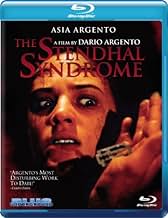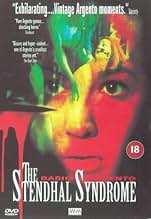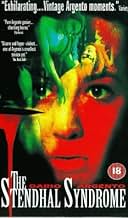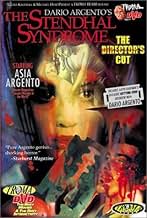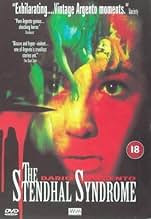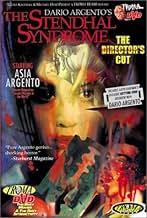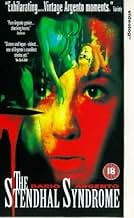IMDb-BEWERTUNG
6,0/10
9647
IHRE BEWERTUNG
Füge eine Handlung in deiner Sprache hinzuA young policewoman slowly goes insane while tracking down an elusive serial rapist/killer through Italy when she herself becomes a victim of the brutal man's obsession.A young policewoman slowly goes insane while tracking down an elusive serial rapist/killer through Italy when she herself becomes a victim of the brutal man's obsession.A young policewoman slowly goes insane while tracking down an elusive serial rapist/killer through Italy when she herself becomes a victim of the brutal man's obsession.
- Auszeichnungen
- 1 Gewinn & 6 Nominierungen insgesamt
Empfohlene Bewertungen
Argento had seen his better days as a movie director and surely it's not easy to top such masterpieces such as Suspiria and The Inferno.
Asia Argento as detective Anna Manni isn't the best casting choice but as an actress she certainly did her best. It's difficult to believe that she really is a police detective at such a young age. It's obvious that a more mature actress should have been cast. Nevertheless that obscurity could have been used to make the film better. Would it be a better film if Anna Manni was just a woman living in her delusions.
The film certainly had it's moments but on the other hand it has some annoying flaws such as very bad cgi effects. Why use experimental effects if they look dumb. They should have gone back in time to the 70's or 80's how they made the effects without computers.
Ennio Morricone's score is amazing though and certainly does a big favor for the film's atmosphere. To sum it up this film is watchable even for Argento fans but it isn't anything like his films used to be. It's really evident that Italian film industry had been in a recession since the late 80's.
Asia Argento as detective Anna Manni isn't the best casting choice but as an actress she certainly did her best. It's difficult to believe that she really is a police detective at such a young age. It's obvious that a more mature actress should have been cast. Nevertheless that obscurity could have been used to make the film better. Would it be a better film if Anna Manni was just a woman living in her delusions.
The film certainly had it's moments but on the other hand it has some annoying flaws such as very bad cgi effects. Why use experimental effects if they look dumb. They should have gone back in time to the 70's or 80's how they made the effects without computers.
Ennio Morricone's score is amazing though and certainly does a big favor for the film's atmosphere. To sum it up this film is watchable even for Argento fans but it isn't anything like his films used to be. It's really evident that Italian film industry had been in a recession since the late 80's.
Argento has been cursed with a number of duds in recent years. 'Two Evil Eyes', 'The Phantom of the Opera', 'Sleepless', 'The Card Player' and one of the worst MASTERS OF HORROR episodes yet 'Jenifer'. However, the beautiful, poignant 'The Stendhal Syndrome' is an extremely well crafted rose between a number of poisonous thorns. It sees a return to the atmospheric dream-like charm of his earlier films like 'Phenomena' and 'Suspiria', but adopting his more recent sadism (it's always there, just a different style in his newer films) that gave slight high points in his otherwise dull modern films. After two poorly reviewed films ('Trauma' and 'Two Evil Eyes') Argento has finally done it right.
The film stars his daughter, Asia (whose interesting relationship with Dario adds to the intriguing and off-beat persona he puts out), as Anna, a beautiful police detective in Rome. When she is targeted by the serial killer she is hunting, she is raped and beaten and so leads Argento's best character study and one of the most intense of his films to date. Rather than following the madman as he offs prostitutes and impressionable young women through Italy (the film lightly touches on it, but the more left to the imagination the better), the film follows Anna as she loses grip on reality and develops a strange disease in which she can ever paintings in her mind and they help solve the case, called the Stendhal Syndrome. As the film goes on the attacks on Anna become more and more vicious, and the final climatic ending is one of Argento's best.
Asia delivers a interesting performance, to say it is good is to stretch the truth, but it is suited to the role and you can tell she has a lot of acting talent. All the other performances are rather flat, but as with all of Agento's films the performances aren't what really matter. The cinematography is bland, but as with Asia's performance suits the film better than if it were Technicolor. The tension and music is amazing, the film devotes itself to really unsettling you, rather than just entertaining you like other recent Argento's. 'The Stendhal Syndrome' is probably the most violent and disturbing I've seen the man go, the rape and murder scenes are gratuitously sadistic and the scenes where Anna is raped are bordering on exploitation.
Overall 'The Stendhal Syndrome' is a fantastic return to form fr Argento, and I hope 'The Third Mother' is anywhere near as well-crafted as this.
7/10
The film stars his daughter, Asia (whose interesting relationship with Dario adds to the intriguing and off-beat persona he puts out), as Anna, a beautiful police detective in Rome. When she is targeted by the serial killer she is hunting, she is raped and beaten and so leads Argento's best character study and one of the most intense of his films to date. Rather than following the madman as he offs prostitutes and impressionable young women through Italy (the film lightly touches on it, but the more left to the imagination the better), the film follows Anna as she loses grip on reality and develops a strange disease in which she can ever paintings in her mind and they help solve the case, called the Stendhal Syndrome. As the film goes on the attacks on Anna become more and more vicious, and the final climatic ending is one of Argento's best.
Asia delivers a interesting performance, to say it is good is to stretch the truth, but it is suited to the role and you can tell she has a lot of acting talent. All the other performances are rather flat, but as with all of Agento's films the performances aren't what really matter. The cinematography is bland, but as with Asia's performance suits the film better than if it were Technicolor. The tension and music is amazing, the film devotes itself to really unsettling you, rather than just entertaining you like other recent Argento's. 'The Stendhal Syndrome' is probably the most violent and disturbing I've seen the man go, the rape and murder scenes are gratuitously sadistic and the scenes where Anna is raped are bordering on exploitation.
Overall 'The Stendhal Syndrome' is a fantastic return to form fr Argento, and I hope 'The Third Mother' is anywhere near as well-crafted as this.
7/10
Argento's main concern as a filmmaker is always with the camera, because for him, the camera is not only something that is used to record the action, but is a constant representation of the eye. This notion is even more important than ever before with The Stendhal Syndrome (1996), Argento's bizarre and brutal thriller, in which an inexplicable affliction pertaining to the relationship between art and the viewer is used as a springboard to a peculiar concoction of murder, rape, identity crisis and pure, psycho-sexual dread.
The story is typical of Argento, with some wonderful references to the classic Giallo style of storytelling found in his earlier films, such as The Bird with the Crystal Plumage (1970), Four Flies on Grey Velvet (1971) and Deep Red (1975), with the continual juxtaposition between the initial police investigation and elements of amateur sleuthing, and all within the broader "stalk and slash" universe of masked killers, wandering point-of-view shots and black leather gloves. However, this is in direct contrast with the incredible viciousness presented by Argento and directed primarily at the central character, in this instance, the young female police investigator, Anna Manni. The treatment of the violence and, in particular, the sexual violence, goes way beyond the brutality of even Tenebrae (1982) or Opera (1988), as the filmmaker attempts to invade a limited psychological space - both in terms of the story and in the visual presentation - that is much deeper and more sinister than anything Argento had done before or since.
The plot here is broken up into two very distinct halves; with the first half showing our protagonist in pursuit of a vicious serial killer who uses her affliction to ensnare her, and the second half showing the breakdown in Anna's personality following a prolonged and violent encounter with the murderer himself. The two different strands are handled well by Argento, with the first half showing his revived interest in the conventions of the Giallo and the second half demonstrating his interest in psychological issues familiar from the masterwork Tenebrae and the largely forgettable American-set thriller Trauma (1993).
There's also a greater attempt to create something approaching reality here, with none of the vivid colours of films like Suspria (1977) and Inferno (1980) or the bravura camera movements or elements of fragmented shot-construction found in Tenebrae and Deep Red. The film points the way forward to subsequent projects, Sleepless (2000) and The Card Player (2005), the latter of the two being something of a thematic sequel to the film in question (though really, this idea makes little to no sense when considered within the context of this film's climax). As bold and different as this presentation is, it must be said that the switch in style isn't entirely successful. There are still a number of slight flaws to the film that we will come back to, but really, it is the occasional drop in quality or the seemingly unbelievable elements of the plot that jar somewhat against the two very distinct and different worlds that the director is trying to create. This still doesn't stop the film from being the best thing that Argento directed in the 90's, and his most enjoyable film overall since Opera almost ten years before.
For me, Sleepless is still the best thing he's directed in the last twenty years, but The Stendhal Syndrome has plenty going for it, even if the abstract concept at the heart of the film may be too outlandish for many to accept. Although there are plot holes and the usual poor dubbing/listless performances, the film makes some valid points about the relationship between art and those that view it, and the always fascinating notions of sight and perception (the things we see and things we feel). Not a masterpiece for certain, but one that regardless offers an interesting idea and some truly thrilling moments of terror and dread.
The story is typical of Argento, with some wonderful references to the classic Giallo style of storytelling found in his earlier films, such as The Bird with the Crystal Plumage (1970), Four Flies on Grey Velvet (1971) and Deep Red (1975), with the continual juxtaposition between the initial police investigation and elements of amateur sleuthing, and all within the broader "stalk and slash" universe of masked killers, wandering point-of-view shots and black leather gloves. However, this is in direct contrast with the incredible viciousness presented by Argento and directed primarily at the central character, in this instance, the young female police investigator, Anna Manni. The treatment of the violence and, in particular, the sexual violence, goes way beyond the brutality of even Tenebrae (1982) or Opera (1988), as the filmmaker attempts to invade a limited psychological space - both in terms of the story and in the visual presentation - that is much deeper and more sinister than anything Argento had done before or since.
The plot here is broken up into two very distinct halves; with the first half showing our protagonist in pursuit of a vicious serial killer who uses her affliction to ensnare her, and the second half showing the breakdown in Anna's personality following a prolonged and violent encounter with the murderer himself. The two different strands are handled well by Argento, with the first half showing his revived interest in the conventions of the Giallo and the second half demonstrating his interest in psychological issues familiar from the masterwork Tenebrae and the largely forgettable American-set thriller Trauma (1993).
There's also a greater attempt to create something approaching reality here, with none of the vivid colours of films like Suspria (1977) and Inferno (1980) or the bravura camera movements or elements of fragmented shot-construction found in Tenebrae and Deep Red. The film points the way forward to subsequent projects, Sleepless (2000) and The Card Player (2005), the latter of the two being something of a thematic sequel to the film in question (though really, this idea makes little to no sense when considered within the context of this film's climax). As bold and different as this presentation is, it must be said that the switch in style isn't entirely successful. There are still a number of slight flaws to the film that we will come back to, but really, it is the occasional drop in quality or the seemingly unbelievable elements of the plot that jar somewhat against the two very distinct and different worlds that the director is trying to create. This still doesn't stop the film from being the best thing that Argento directed in the 90's, and his most enjoyable film overall since Opera almost ten years before.
For me, Sleepless is still the best thing he's directed in the last twenty years, but The Stendhal Syndrome has plenty going for it, even if the abstract concept at the heart of the film may be too outlandish for many to accept. Although there are plot holes and the usual poor dubbing/listless performances, the film makes some valid points about the relationship between art and those that view it, and the always fascinating notions of sight and perception (the things we see and things we feel). Not a masterpiece for certain, but one that regardless offers an interesting idea and some truly thrilling moments of terror and dread.
La Syndrome di Stendahl has met cruel critical comments on its initial release but although it is not at all like his earlier work, it is in fact a far more intelligent and mature affair. Anna Manni, the character played by Asia Argento, has more compassion than any other character in an Argento film, quite unlike the carelessly created cartoon-like characters of his other work. It is true, however that the film drags slightly in the middle, although picks up the pace again for a surprising and beautifully directed finale; and although the film is not as bloody as tenebrae, the violence on display is brutal and sexual (leading to it being cut for release in Britain) and genuinely disturbing. Perhaps not as good as Deep Red or Suspiria, but definitely one of this unusual director's better efforts.
Regarded as one of Argento's lesser works, I find this one much more plausible than any of his early films. Let's face it, Argento doesn't care much about plot or even acting. His films are probably the frustrating I've ever seen: There are things I love, and things I hate about them. I grew up watching much of his films mutilated by Italian Television. I was a kid back then, and strangely enough his films never scared me when they were supposed to. They were really over the top. But I loved the colours, the pictures and once in a while I found myself humming Claudio Simonetti's electronic scores.
Now with this film Argento has Morricone, who is definitely a master and he does a great job here. Anna's character is really intriguing. Some people dismiss Asia's acting style, but I think it goes very well with her father's aesthetics. You wont find the crazy colours here. Everything is more restrained. The opening for example scene is great. But the film looses interest towards the end. Still I think is one of Argento's most solid pieces. The idea is truly interesting and Anna's relationship with the killer is fascinating. The hallucinations scenes of Anna going into the paintings are masterfully done.
After the huge disappointment of Il Cartaio, I hope he truly returns to form, and start doing what he's good at: Going crazy with film. La Sindrome Di Stendhal is a pretty good step.
Now with this film Argento has Morricone, who is definitely a master and he does a great job here. Anna's character is really intriguing. Some people dismiss Asia's acting style, but I think it goes very well with her father's aesthetics. You wont find the crazy colours here. Everything is more restrained. The opening for example scene is great. But the film looses interest towards the end. Still I think is one of Argento's most solid pieces. The idea is truly interesting and Anna's relationship with the killer is fascinating. The hallucinations scenes of Anna going into the paintings are masterfully done.
After the huge disappointment of Il Cartaio, I hope he truly returns to form, and start doing what he's good at: Going crazy with film. La Sindrome Di Stendhal is a pretty good step.
Wusstest du schon
- WissenswertesThe opening scene was shot inside the famous Uffizi Gallery in Florence. As of 2014, Dario Argento is the only director who's ever received permission to film inside the museum.
- PatzerThough featuring prominently during the film's opening sequence set at the Uffizi in Florecne, Peter Bruegel's 'Landscape with the Fall of Icarus' is actually housed at the Royal Museum of Fine Arts of Belgium in Brussels.
- Zitate
Insp. Manetti: You're young. I can trust you.
- Alternative VersionenUS DVD release by Troma release is the complete version of the English language edition, but, like all English releases, is still missing around 2 minutes of material exclusive to the Italian print.
Top-Auswahl
Melde dich zum Bewerten an und greife auf die Watchlist für personalisierte Empfehlungen zu.
Details
Box Office
- Budget
- 3.800.000 $ (geschätzt)
- Laufzeit
- 2 Std.(120 min)
- Farbe
- Sound-Mix
- Seitenverhältnis
- 1.85 : 1
Zu dieser Seite beitragen
Bearbeitung vorschlagen oder fehlenden Inhalt hinzufügen



